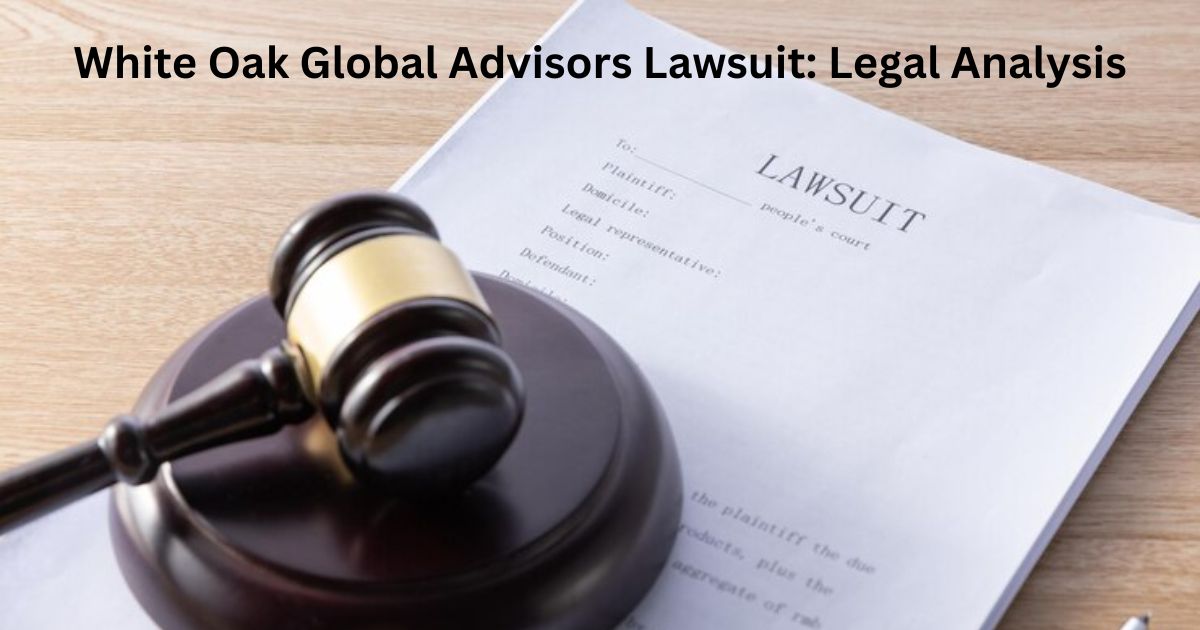Ever wondered what happens when a big-name investment firm faces legal heat? Buckle up, because we’re diving into the White Oak Global Advisors lawsuit. This isn’t just another corporate drama – it’s a case that’s got the financial world buzzing.
From mismanagement claims to SEC involvement, we’re breaking it all down in plain English. Whether you’re an investor, industry pro, or just curious about high-stakes financial showdowns, this analysis is your ticket to understanding what’s at stake.
Introduction to White Oak Global Advisors
Picture this: A company that’s been a big player in the investment game for years suddenly finds itself in hot water. That’s White Oak Global Advisors for you. But before we jump into the legal drama, let’s rewind and get to know this financial powerhouse.
Background and History
White Oak Global Advisors burst onto the scene in 2007, and boy, did they make waves. These folks weren’t just another face in the crowd – they quickly became the go-to for businesses looking for tailored credit solutions.
With a focus on dishing out top-notch risk-adjusted returns, they’ve been managing billions in assets. It’s like they found the secret sauce in the world of finance, and everyone wanted a taste.
Business Operations and Investments
So, what’s White Oak’s bread and butter? They’re all about those alternative investments and direct lending. Think of them as the financial world’s problem solvers, offering everything from investment strategies to credit management.
Their secret? A laser focus on careful checks, risk evaluation, and hands-on portfolio management. They’ve got their fingers in various pies – wholesale, manufacturing, you name it. It’s this jack-of-all-trades approach that’s made them a go-to partner for businesses across three continents.
Overview of the White Oak Global Advisors Lawsuit
Now, here’s where things get spicy. The White Oak Global Advisors lawsuit isn’t just water cooler gossip – it’s a full-blown legal battle that’s got everyone from Wall Street to Main Street talking. The gist? Investors are crying foul, claiming White Oak dropped the ball big time when it came to managing their hard-earned cash.
We’re talking serious allegations here – mismanagement, broken promises, the works. Investors aren’t just grumbling; they’re taking White Oak to court, saying the firm made moves that left their investments in the dust. And it’s not just about money – it’s about trust. The lawsuit claims White Oak kept investors in the dark, not spilling the beans on crucial info about investments and risks.
Key Allegations and Legal Grounds

Let’s break down the nitty-gritty of what’s got investors so riled up. The White Oak Global Advisors lawsuit isn’t just throwing around vague accusations – we’re talking specific, hefty claims that could make or break the case.
Misrepresentation of Financial Information
Here’s the deal: investors are saying White Oak played fast and loose with the numbers. We’re not talking about a little fudging here and there – the lawsuit alleges the firm served up a heaping plate of false or misleading financial info.
Think inflated performance reports or downplayed risks. The result? Investors claim they were led down a garden path, making decisions based on a financial fairy tale rather than cold, hard facts.
Breach of Fiduciary Duties
Now, this is where things get really sticky. In the world of finance, fiduciary duty is like a sacred oath – it’s all about putting your clients’ interests first. The lawsuit claims White Oak didn’t just drop the ball; they threw it out of the stadium.
We’re talking allegations of not acting in investors’ best interests, making moves that benefited the firm more than the folks trusting them with their cash. It’s like hiring a financial guardian angel and finding out they’ve been playing for the other team.
| Key Allegations | Legal Grounds |
| Misrepresentation of financial information | Breach of fiduciary duties, securities regulations, and contractual obligations |
| Failure to act in the best interests of investors | Breach of fiduciary duties, violation of fiduciary responsibilities |
| Mismanagement of funds and improper management of client assets | Breach of fiduciary duties, violation of fiduciary responsibilities |
Parties Involved in the Lawsuit
This legal showdown isn’t just White Oak versus the world – it’s got a cast of characters that would make a courtroom drama jealous. Let’s meet the players in this high-stakes financial face-off.
Plaintiffs
In one corner, we’ve got the plaintiffs – the investors who trusted White Oak with their money and now feel like they’ve been taken for a ride. These aren’t just faceless entities; we’re talking about real people and organizations who put their financial futures in White Oak’s hands. They’re the ones who’ve raised the red flag, claiming their investments took a nosedive thanks to White Oak’s alleged missteps.
Defendants
And in the other corner, we’ve got White Oak Global Advisors and some of its big cheeses. We’re talking top executives and board members – the folks who call the shots. They’re the ones in the hot seat, facing accusations that could shake the very foundations of their company. Their mission? To prove these allegations are nothing but hot air and keep their reputation (and their business) intact.
Timeline of Events
Alright, let’s hit rewind and walk through how this whole legal drama unfolded. It’s like a financial thriller, but with more paperwork and less car chases.
Early 2023: The first whispers of trouble start circulating. Investors begin raising eyebrows at some of White Oak’s moves.
Mid-2023: Things heat up as the lawsuit officially hits the courts. It’s no longer just talk – it’s legal action time.
September 18, 2023: A key player, Isaac Soleimani, gets the boot from White Oak. This shakeup adds fuel to the already blazing fire.
February 6, 2024: The case gets its day in court as it’s officially brought before a judge.
April 12, 2024: A decision drops, but this story’s far from over.
May 14, 2024: The plot thickens as Matthew A. Kezhaya joins the legal fray.
May 29, 2024: Mark your calendars – this is when both sides are set to duke it out in a telephonic showdown.
June 11, 2024: Another court date looms on the horizon, with all eyes on what could be a game-changing meeting.
Response from White Oak Global Advisors
Now, you didn’t think White Oak was just going to roll over, did you? They’ve come out swinging, and their response is nothing short of a full-on counterattack.
First things first, White Oak’s calling BS on the whole shebang. They’re not just denying the allegations; they’re dismissing the entire lawsuit as “without merit.” It’s like they’re saying, “Lawsuit? What lawsuit? We’ve been too busy managing $11.5 billion in assets to notice.”
But they’re not just playing defense. White Oak’s pulling out the big guns, touting their track record and reminding everyone why they became a big deal in the first place. They’re talking about their commitment to transparency, their by-the-book approach to regulations, and their stellar history of keeping clients happy.
| Key Points in White Oak’s Response | Details |
| Denial of Allegations | White Oak Global Advisors has firmly denied all claims made against the firm in the lawsuit, stating that its actions were fully compliant with legal and regulatory requirements. |
| Commitment to Transparency and Fiduciary Responsibility | The firm has emphasized its dedication to maintaining the highest standards of transparency and fiduciary responsibility in managing its clients’ assets. |
| Successful Track Record | White Oak Global Advisors has highlighted its impressive track record in managing over $11.5 billion in assets across a diverse range of investment strategies. |
| Dismissal of Lawsuit | The firm has dismissed the lawsuit as “without merit” and remains committed to vigorously defending its position. |
Impact on Stakeholders and Financial Implications

Let’s face it – when a lawsuit hits a big financial player like White Oak, the ripples spread far and wide. We’re not just talking about a few nervous investors; this thing’s got implications that could shake up the whole financial ecosystem.
Effects on Investors and Clients
For the folks who’ve got skin in the game with White Oak, this lawsuit is like a financial rollercoaster they never signed up for. Investors are side-eyeing their portfolios, wondering if they should jump ship or ride out the storm.
It’s not just about the money either – trust is on the line here. White Oak’s scrambling to keep their clients from heading for the hills, but let’s be real: once that seed of doubt is planted, it’s tough to uproot.
Consequences for Employees and Partners
And what about the people inside White Oak’s walls? Employees are probably feeling like they’re walking on eggshells, wondering if their jobs are on the chopping block. Partners and other firms tied to White Oak? They’re in a sticky situation too, caught between loyalty and self-preservation. It’s like being on a team where the star player just got caught doping – do you stick by them or start looking for a new jersey?
Regulatory and Legal Perspectives
Now, let’s zoom out and look at the bigger picture. This isn’t just about White Oak – it’s a case that could set the tone for the entire financial industry.
Compliance Requirements and Precedents
Here’s the deal: the financial world is like a high-stakes game of Jenga, and compliance is the foundation. One wrong move, and the whole thing could come tumbling down. The White Oak case is shining a spotlight on just how crucial those compliance rules are. We’re talking about everything from how firms handle client money to how they report their own finances.
| Compliance Requirement | Relevant Precedents |
| Fiduciary Duty | SEC v. Brokerage Firm (2019): $30 million penalty for breach of fiduciary duty |
| Risk Disclosure | Investor v. Asset Manager (2016): $20 million settlement for failure to disclose investment risks |
| Fund Mismanagement | Pension Fund v. Investment Firm (2021): $50 million settlement for misappropriation of client assets |
But here’s where it gets really interesting: this case could set some serious precedents. Depending on how it shakes out, we could see new rules, stricter oversight, or even a whole new playbook for how investment firms operate. It’s like when a ref makes a controversial call in a championship game – that decision could change how the sport is played for years to come.
Public Reaction and Media Coverage
You better believe this story’s got people talking. From Twitter to CNBC, the White Oak lawsuit is prime-time news fodder.
The public’s reaction? It’s a mixed bag. Some folks are grabbing their pitchforks, ready to storm Wall Street over yet another case of alleged corporate misconduct. Others are taking a more wait-and-see approach, not ready to throw White Oak under the bus just yet.
Media coverage has been relentless. Financial news outlets are having a field day, breaking down every legal filing and speculating on what it all means. Social media’s buzzing too, with armchair analysts and meme-makers alike weighing in on the drama.
But it’s not just noise – this coverage is shaping public opinion and could even influence the case itself. It’s like a courtroom drama playing out in real-time, with the whole world watching.
Read Also: Pedrovazpaulo Coaching: A Program for Personal and Professional Growth
Comparative Analysis
Alright, let’s put on our detective hats and look at how the White Oak case stacks up against other financial face-offs we’ve seen.
Remember the Citigroup Global Markets fiasco back in 2010? That was a doozy – $285 million settlement for not playing straight with investors about subprime mortgage risks. Or how about the Madoff scandal? That Ponzi scheme was the granddaddy of financial fraud, showing just how badly things can go south when oversight takes a vacation.
More recently, we’ve got the Och-Ziff Capital Management bribery case from 2016. Different flavor of trouble, same lesson: when big money’s involved, the temptation to cut corners can be huge.
Key Takeaways from Comparable Lawsuits:
- Transparency isn’t just nice to have; it’s a must-have. Hiding the ball from investors is a one-way ticket to legal trouble.
- Strong, independent oversight isn’t just red tape – it’s a lifesaver for both firms and investors.
- Following the rules isn’t enough; firms need to embrace the spirit of financial regulations, not just the letter.
- When things go south, how a firm responds can be just as important as what they did wrong in the first place.
The Role of Technology in Preventing Financial Misconduct

Here’s a curveball: could tech be the answer to preventing these kinds of financial dust-ups?
We’re talking AI that can spot irregularities in financial reports before they become full-blown scandals. Blockchain tech that makes every transaction transparent and traceable. Big data analytics that can predict risk with scary accuracy.
But it’s not just about fancy gadgets. It’s about creating a culture where tech and ethics go hand in hand. Where compliance isn’t just a box to tick, but a core part of how business gets done.
The Human Element: Building Trust in Finance
At the end of the day, finance isn’t just about numbers – it’s about people. And people need trust.
The White Oak case is a stark reminder that in finance, your word is your bond. Building and maintaining trust isn’t just good ethics; it’s good business.
It’s about creating a culture where doing right by your clients is as important as the bottom line. Where transparency isn’t just a buzzword, but a way of life.
Because when the dust settles on cases like White Oak, the firms left standing will be the ones that remembered the most important investment of all: investing in trust.
The Global Impact of Financial Misconduct Cases
Let’s zoom out even further and consider the ripple effects of cases like White Oak’s on the global financial stage.
These high-profile legal battles don’t just shake up individual firms; they can rattle entire markets. Investor confidence takes a hit, and not just in the U.S. We’re talking worldwide jitters. When big players stumble, it makes everyone question the game.
But it’s not all doom and gloom. These cases often spark international dialogue on financial regulations. Countries start comparing notes, asking, “How can we prevent this in our backyard?” It’s like a global financial neighborhood watch, with everyone keeping an eye out for trouble.
The Role of Whistleblowers in Financial Integrity
Here’s a plot twist worth considering: whistleblowers. These insider informants often play a crucial role in uncovering financial misconduct.
In cases like White Oak’s, whistleblowers can be the canary in the coal mine, alerting regulators to problems before they balloon into full-blown crises. But it’s not an easy gig. Whistleblowers often risk their careers and reputations to do what they think is right.
The financial industry’s attitude towards whistleblowers is evolving. More firms are setting up internal channels for reporting concerns, recognizing that it’s better to hear bad news early than face a PR nightmare later.
The Psychological Impact on Investors

Let’s talk about the elephant in the room: investor psychology. When news of lawsuits like White Oak’s breaks, it doesn’t just hit portfolios; it hits psyches.
Investors start second-guessing everything. That rock-solid investment strategy? Suddenly it feels like quicksand. It’s not just about money lost; it’s about trust shattered.
This psychological fallout can lead to broader market instability. Panic selling, overly cautious investing, or even pulling out of the market entirely – these emotional reactions can have real economic consequences.
Smart firms are recognizing this and focusing not just on financial performance, but on investor education and communication. It’s about building resilience, not just returns.
The Evolution of Financial Education in Light of High-Profile Cases
Here’s a silver lining: cases like White Oak’s are changing how we think about financial education.
Universities are updating their finance curricula, adding more emphasis on ethics and real-world case studies. It’s not just about crunching numbers anymore; it’s about understanding the human impact of financial decisions.
But it’s not just for finance majors. There’s a growing push for financial literacy at all levels. The idea? The more people understand how the financial world works, the harder it is to pull the wool over their eyes.
The Intersection of Finance and Politics
Let’s not forget the political angle. High-profile financial misconduct cases often become political footballs.
Lawmakers start calling for hearings. Regulators face pressure to tighten the screws. It becomes a talking point in election campaigns.
This political dimension can lead to new legislation, stricter enforcement, or even structural changes in how the financial industry is overseen. It’s a reminder that finance doesn’t operate in a vacuum – it’s deeply intertwined with the broader societal and political landscape.
Future Prospects and Expert Opinions
So, what’s next for White Oak and the financial world at large? Experts are split, but here’s the skinny:
Some legal eagles think the plaintiffs have a solid case, pointing to the mountain of evidence they claim to have. Others say White Oak’s got some strong defenses up its sleeve and might just weather this storm.
One thing’s for sure: whatever happens, this case is going to leave a mark. We could be looking at stricter regulations, more transparency requirements, or a whole new way of doing business in the financial sector.
Settlement talks? Don’t rule ’em out. Sometimes, a handshake deal behind closed doors is better than a drawn-out court battle for all parties involved.
Lessons for the Financial Industry

Let’s zoom out and ask: what can the whole financial world learn from this White Oak saga?
First up, the importance of robust risk management can’t be overstated. It’s not just about avoiding lawsuits; it’s about building a sustainable, trustworthy business.
Transparency is key. In an age where information travels at the speed of light, trying to keep investors in the dark is a recipe for disaster.
Ethics matter. It’s not just about following the rules; it’s about doing right by your clients, even when no one’s looking.
Lastly, adaptability is crucial. The financial world is always evolving, and firms need to be ready to change with it – or risk being left behind.
Read Also: Jones Church Loans: Empowering Faith-Based Organizations
FAQ’s
What’s the White Oak Global Advisors lawsuit all about?
The lawsuit claims White Oak mismanaged investor funds. Allegations include financial misrepresentation and breach of trust. Investors say the firm made decisions that hurt their investments. The case highlights issues of corporate governance in finance.
How might this lawsuit affect White Oak’s clients?
Clients may face uncertainty about their investments. Trust in White Oak could be severely damaged. Some investors might consider withdrawing their funds. The firm’s reputation and client relationships are at stake.
What are the potential outcomes of this lawsuit?
White Oak could face hefty fines if found guilty. The firm might need to pay damages to affected investors. Stricter regulations for the financial industry could result. A settlement out of court is also possible.
How does this case compare to other financial lawsuits?
It’s similar to cases involving misrepresentation of financial info. The scale is significant, but not unprecedented in finance. It echoes themes of breach of fiduciary duty seen in other cases. The outcome could set new precedents for the industry.
What can other financial firms learn from this case?
Transparency with clients is crucial. Strong internal oversight can prevent similar issues. Ethical practices should be a top priority. Rapid response to client concerns is important.
Conclusion
Imagine a big-name investment firm suddenly in hot water. That’s White Oak right now. Investors are crying foul, saying the firm played fast and loose with their cash. We’re talking allegations of fudged numbers and broken promises. It’s got everyone from Wall Street to Main Street buzzing.
White Oak’s fighting back, saying it’s all nonsense. But the damage is done. Clients are nervous, employees are sweating, and the whole financial world is watching.
This isn’t just about one company. It’s a wake-up call for the entire industry. Trust, transparency, and doing right by your clients – that’s what’s really on trial here.

Hello, I’m Scarlett Autumn an author at Trendyloams.com, specializing in Business, Tech, Lifestyle, and News. My writing offers insightful analysis and engaging content, covering a wide range of topics. With a talent for simplifying complex concepts, I ensure my work is both accessible and thought-provoking. Follow me on Trendyloams.com for fresh perspectives and the latest updates on what’s shaping the world of business, technology, and beyond.

